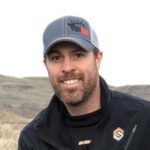LAST UPDATED: May 8th, 2015
The deer you’ve been waiting for all season steps out of the thicket at a mere twenty yards. As if he was reading from a script he enters your lane and turns broadside looking the other direction… you settle your pin behind the shoulder and watch your arrow disappear over a foot farther back than you were aiming. Sound familiar? Maybe not the scenario, but the result is something that 99% of the bowhunting will or has experienced. It’s what you do after a poor shot that can determine whether or not your deer is recovered.
Understanding the “why” of any given hunting situation, not only makes me better, but is something that I owe to the animal I’m hunting. Understanding “why” a deer may do something after the shot increases your odds of finding that deer. For instance deer that are “gut shot” lose body fluid internally and naturally they become thirsty, the natural way to replenish fluids. In the event that a blood trail is lost on a poorly shot deer, the nearest water source is the first place I’ll look.
All the images below represent actual deer that were shot poorly and recovered. A couple of them I shot, others were buddies that I was part of the tracking expedition. Notice the similarities between the tracks. The “J” or “hook” shape is present on nearly every deer, notice the proximity to the nearest water source (water is not marked). These are things to keep in mind in the event that you find yourself on the trail of a gut shot deer. I will add that probably the most important factor in the recovery of all these deer, is that they were not pushed (to my knowledge) and the majority of them were found dead in their bed.
The use of tracking aids truly are incredible at helping you see a pattern or a patch when tracking in the dark.
This buck was shot one evening in 2005, left overnight and recovered the next morning.
This doe was shot one evening in 2005, left overnight and recovered the next morning.
Justin’s buck killed in 2009
This buck was shot one evening in 2007, left overnight and recovered the next morning.
This buck was shot one morning in 2004, left all day and recovered the same evening.
This doe was shot one morning in 2004 and recovered the next morning.
This doe was shot one evening in 2003, left overnight and recovered the nex morning.
As simple as these concepts seem, they’re overlooked time and time again throughout the archery season. The best tools we have at our disposal are our past experiences or those of fellow hunters. It’s my hope that what little bit of information this provides can help you in your next tracking journey.

 By
By .jpg)
.jpg)
 (500 x 333).jpg)
.jpg)
.jpg)
.jpg)
.jpg)




